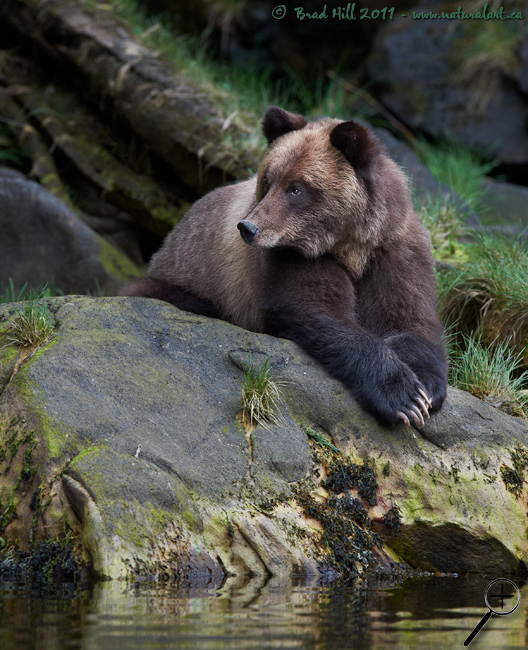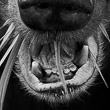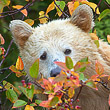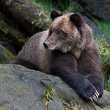Availability: Undetermined - Enquiries?
In the Field
Intrigued. Khutzeymateen Inlet (Great Bear Rainforest), BC, Canada. May 25, 2011.
During my visit to the Khutzeymateen Inlet in the spring of 2011 we had a lot of gentle, "cooperative" bears to work with (along with a few "testier" individuals of course!). I found this female grizzly amazingly attractive (settle down Willy - I mean "attractive for a bear!") - just a fantastic range of browns on its body and with those tones arranged in a very pleasing manner (great markings!). Plus it had the most compelling eyes...
This image was shot after sunset - we were watching the bear work the shoreline and then it decided to come to rest on a rock not far in front of us. For the bulk of the time the bear was resting on its big paws and dozing off - which clearly told us the bear was VERY comfortable with our presence. At one point, though, the bear sensed something new in its perceptual world and quickly raised its head and appeared absolutely intrigued by "something" in the distance for a few seconds. I found the pose irresistible and snapped off a burst of shots. To me the natural composition worked very well - everything from the leading lines (towards the head) provided by the background logs through to the beautifully "adorned" rock (and of course, the soft water in the foreground.
My input into the production of the image? I mentioned above this image was shot after sunset - so think low light. While I generally subscribe to the "always minimize ISO" philosophy this is one instance where I actively decided to let the ISO climb up to moderately high levels (ISO 2000). Because I was using a fast prime lens (400mm f2.8), I COULD have opened the aperture up wide and shot this image at quite a low ISO (500 or so) while still maintaining a hand-holdable shutter speed. But, to my eye, the success of this image was totally dependent on keeping the ENTIRE bear and the ENTIRE rock in sharp focus - which meant stopping down (in this case, to f5.6). And, the only way to do this while keeping the shutter speed hand-holdable was to "give" on the ISO. And that, in a nutshell, is the reason I REALLY like shooting with cameras with good high ISO performance - they allow you to really "own" your aperture and depth-of-field and thus give you so much more creative control over your final image.
Another comment on this image: with today's best cameras it is possible to shoot far more scenes in dim or near-dark conditions. If you "let" your camera's light meter "do it's thing" (especially when using Matrix or Evaluative metering modes) the end result will often be a scene FAR brighter than you observed (i.e., they can pretty much turn twilight into daylight, and the camera WILL do this if you let it). So...if you want to maintain the soft, low-light look you often have to UNDER expose the image (either in-camera or during raw processing).
NOTE: This image was captured in a region of British Columbia known as "The Great Bear Rainforest". I offer both instructional photo tours and "photo op only" photo tours into the Great Bear Rainforest each spring and autumn. If you're interested in more information about one of these tours, details are available on the Photo Tours page of this website!
Alert - Digitally Manipulated Image: This image clearly crosses the line from simple digital correction to digital manipulation. During post-production I digitally removed (NOT using the clone tool!) a branch near the butt of the bear and 1 piece of grass off the bear's fur.
It is my policy to clearly identify ANY images on this website that overstep the bounds of digital correction and enter the territory of digital manipulation (see Voice: Commentary: Digital Correction vs. Digital Manipulation).
Behind the Camera
Intrigued. Khutzeymateen Inlet (Great Bear Rainforest), BC, Canada. May 25, 2011.
Digital Capture; RAW 14-bit format; ISO 2000.
Nikon D3s with Nikkor 400mm f2.8 VR lens. Hand-held from floating Zodiac inflatable boat (VR on and in normal mode).
1/250s @ f5.6; no compensation from matrix-metered exposure setting.
At the Computer
Intrigued. Khutzeymateen Inlet (Great Bear Rainforest), BC, Canada. May 25, 2011.
RAW Conversion to 16-bit TIFF, including first-pass/capture sharpening using Phase One's Capture One Pro 6. Four raw conversions varying in exposure settings over a 1.5 stop range (-1.5 stops from original capture exposure setting to 0 stops from capture settings).
Further digital corrections on 16-bit TIFF file using Adobe's Photoshop CS5 and LightCraft's Lightzone. Photoshop adjustments including blending of 4 exposure versions, selective exposure and tone curve adjustment, selective colour saturation and desaturation, and selective sharpening for web output. Final tonemapping and contrast/tone tweaking - especially to midtones on rock and on bear's head - performed with LightZone using the tonemapper/re-light tool.
Conservation
Intrigued. Khutzeymateen Inlet (Great Bear Rainforest), BC, Canada. May 25, 2011.
Ten percent of the revenue generated by this image will be donated to Raincoast*.
Species Status in Canada**: Special Concern (May 2002).
While Grizzly Bears (Ursus arctos) are not technically listed as "Endangered" in Canada, they have been extirpated from most of their historical range. Grizzly Bears are far more sensitive to intrusion/disturbance in their habitat than are Black Bears and are being increasingly forced into marginal habitat by human encroachment. The Great Bear Rainforest along the central and northern coast of British Columbia is one of the last strongholds of the Grizzly Bear in Canada, and even this population is coming under increasing pressure.
On December 18, 2017 the government of British Columbia banned grizzly hunting across the entire province. This major conservation victory came after decades of tireless work by many dedicated conservationists and ecologists and, most importantly, it reflects the opinion of the vast majority of British Columbians. And, it means that AT LEAST while the current government remains in power grizzlies are finally "safe" in British Columbia.
Now that we've at least temporarily won the battle to save grizzlies in BC, it's time to re-focus our efforts toward protecting ALL of BC's carnivores, including Gray Wolves, Black Bears, Cougars, Wolverines, and more! Simply put, there are no ecological, economic, or ethical arguments supporting the trophy hunting of carnivores.
In a great first step towards ending the hunting of carnivores throughout BC the Raincoast Conservation Foundation has developed a program designed to protect ALL carnivores within the Great Bear Rainforest. Details about this program can be found on this page on Raincoast's website. Check it out and, better yet, make a donation to help Raincoast purchase the remaining commercial hunting tenures in the Great Bear!
*The Raincoast Conservation Society (and Foundation) is an effective and efficient organization that has been fighting for protection of this unique habitat. If you are looking for a meaningful way to contribute to the conservation of this amazing ecosystem, Raincoast will provide maximal "bang" for your conservation dollars.
**as determined by COSEWIC: The Committee on the Status of Endangered Wildlife in Canada

























